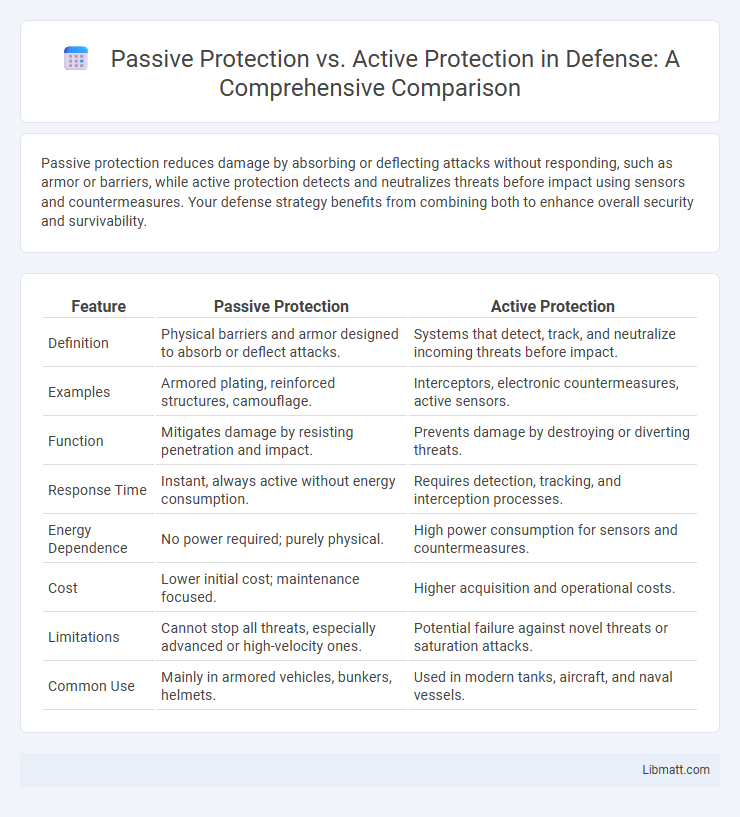Passive protection reduces damage by absorbing or deflecting attacks without responding, such as armor or barriers, while active protection detects and neutralizes threats before impact using sensors and countermeasures. Your defense strategy benefits from combining both to enhance overall security and survivability.
Table of Comparison
| Feature | Passive Protection | Active Protection |
|---|---|---|
| Definition | Physical barriers and armor designed to absorb or deflect attacks. | Systems that detect, track, and neutralize incoming threats before impact. |
| Examples | Armored plating, reinforced structures, camouflage. | Interceptors, electronic countermeasures, active sensors. |
| Function | Mitigates damage by resisting penetration and impact. | Prevents damage by destroying or diverting threats. |
| Response Time | Instant, always active without energy consumption. | Requires detection, tracking, and interception processes. |
| Energy Dependence | No power required; purely physical. | High power consumption for sensors and countermeasures. |
| Cost | Lower initial cost; maintenance focused. | Higher acquisition and operational costs. |
| Limitations | Cannot stop all threats, especially advanced or high-velocity ones. | Potential failure against novel threats or saturation attacks. |
| Common Use | Mainly in armored vehicles, bunkers, helmets. | Used in modern tanks, aircraft, and naval vessels. |
Introduction to Passive and Active Protection
Passive protection relies on physical barriers, such as armor plating and reinforced structures, to absorb or deflect damage without requiring user intervention. Active protection employs advanced technologies like sensors, interceptors, and automated countermeasures to detect and neutralize threats in real time. Understanding the differences between these systems helps you optimize defense strategies for vehicles, buildings, or personal safety equipment.
Defining Passive Protection Systems
Passive protection systems consist of physical barriers like armor plating, reinforced structures, and blast-resistant materials designed to absorb and mitigate damage without requiring external input or power. These systems passively safeguard assets by minimizing the impact of threats such as explosions, gunfire, or collisions through inherent material strength and design. Understanding the limitations and strengths of passive protection helps optimize your defense strategies in environments where active systems may fail or be unavailable.
Defining Active Protection Systems
Active Protection Systems (APS) are advanced defensive technologies designed to detect, track, and neutralize incoming threats such as rockets, missiles, or projectiles before impact. These systems use sensors, radars, and interceptors to engage and destroy or deflect threats in real-time, significantly enhancing battlefield survivability. Unlike passive protection methods, which rely on armor or barriers to absorb impact, APS provides a proactive shield by preventing attacks from reaching the protected asset.
Key Differences Between Passive and Active Protection
Passive protection relies on static barriers or materials, such as armor plating or fire-resistant coatings, to prevent damage without requiring energy input. Active protection systems use sensors and countermeasures, like electronic jamming or interceptors, to detect and neutralize threats in real time. The key differences lie in their operational approach: passive protection provides constant physical defense, while active protection dynamically responds to incoming dangers.
Mechanisms of Passive Protection
Mechanisms of passive protection primarily involve physical barriers such as armor plating, reinforced structures, and protective coatings designed to absorb or deflect incoming threats without requiring active intervention. These systems rely on material properties like hardness, thickness, and energy-dissipating layers to shield critical components from damage. Your defense strategy benefits from passive protection by ensuring continuous, maintenance-free safeguarding against impacts and environmental hazards.
Mechanisms of Active Protection
Active protection mechanisms employ sensors, interceptors, and countermeasures to detect and neutralize incoming threats before impact, ensuring superior defense compared to passive armor. Systems like Trophy or Iron Fist use radar or infrared detection to identify projectiles, then deploy explosively formed penetrators or directed energy to destroy or deflect them mid-flight. Your vehicle's survivability significantly increases with active protection, as these technologies dynamically respond to threats rather than relying solely on absorbing damage.
Advantages of Passive Protection
Passive protection offers significant advantages by providing continuous, maintenance-free defense without relying on electronic systems or power sources. It enhances structural durability and safety through materials like reinforced concrete, armor plating, or fire-resistant coatings, effectively absorbing or deflecting impacts. This reliability under extreme conditions and reduced likelihood of failure make passive protection ideal for safeguarding critical infrastructure and military assets.
Advantages of Active Protection
Active protection systems offer real-time threat detection and interception, significantly enhancing vehicle survivability against modern anti-tank weapons. Their dynamic response capabilities reduce damage by neutralizing incoming projectiles before impact, unlike passive protection, which relies on armor thickness and material strength alone. Integration of sensors, countermeasures, and automated response mechanisms makes active protection highly adaptable to diverse combat environments and evolving threats.
Challenges and Limitations of Each Approach
Passive protection faces challenges such as limited adaptability to evolving threats and reliance on physical barriers which can be bypassed or degraded over time. Active protection systems encounter limitations including high operational costs, complexity in integration, and potential for false positives that may disrupt normal activities. Both approaches require continuous updates and maintenance to address emerging vulnerabilities effectively.
Choosing the Right Protection Strategy
Choosing the right protection strategy involves evaluating your specific security needs to balance passive protection, such as armor plating and electronic countermeasures, with active protection systems that detect and neutralize incoming threats in real-time. Passive protection provides a reliable baseline defense by strengthening structural resilience, while active protection enhances survivability through advanced sensors and automated interceptors designed to counter missiles or projectiles. Your optimal strategy depends on factors like threat environment, operational context, and available technology integration.
passive protection vs active protection Infographic

 libmatt.com
libmatt.com